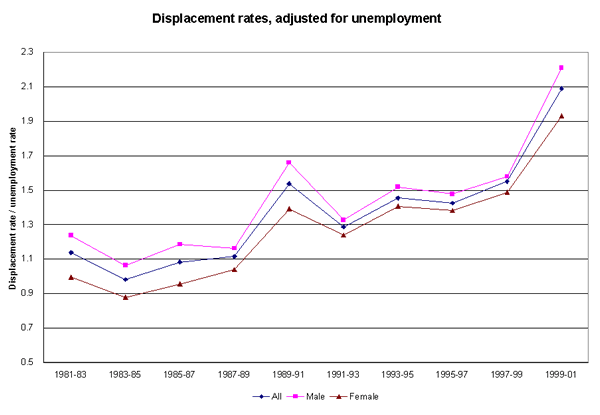A weekly presentation of downloadable charts and short analyses designed to graphically illustrate important economic issues. Updated every Wednesday.
Snapshot for August 28, 2002.
Employment insecurity
Over the past decade, polling data and other sources have revealed greater employment insecurity among workers, despite the fact that the labor market was historically tight in the latter 1990s. How is it that tighter labor markets have generated higher levels of employment insecurity?
One explanation is shown in the figure below. The data in the figure are displacement rates-the share of workers, by gender, who lost their job-divided by the unemployment rate. We use this measure to adjust the displacement rates for the strength of the labor market. That is, as unemployment declines, we expect displacement rates to fall, a pattern which is roughly visible in the displacement rate series (not shown). But, as the figure shows, relative to the unemployment rate, the rate of job loss due to layoffs has trended up over time.

A cyclical effect is evident in the figure, with displacement rates increasing relative to unemployment in recessions (the 1989-91 and 1999-01 observations are dominated by this effect). Still, the series is higher in the 1990s than in the prior decade throughout the business cycle (note the 1999-01 spike for males driven largely by manufacturing layoffs). Even adjusting for the tighter labor markets of the latter 1990s, workers were more likely to be laid off relative to earlier periods.
Data Note: The displacement rates are the number of persons, 20 years and older, who lost their job over a three-year period due to permanent layoff divided by average employment over that same period. The unemployment rates (also for persons 20+) are averaged over the three years as well. Note that half of the 9.9 million displacements in the 1999-01 period occurred in the recessionary year of 2001.
This week’s Snapshot by EPI economist Jared Bernstein.
Check out the archive for past Economic Snapshots.
